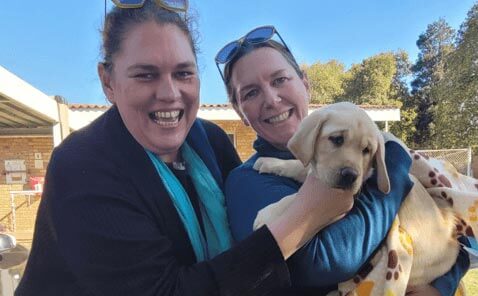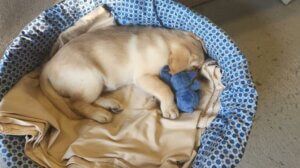There is nothing ordinary about Kato, not even his name!

It is a big decision to foster a puppy, let alone a puppy that is being raised to be a guide dog, it puts a huge responsibility on your shoulders.
We wanted to speak to a family that has first-hand experience with fostering a guide dog to get a better understanding of exactly what it entails, the impact it has on the family, and the commitment it takes to ensure that eventually, the puppy grows into a fully trained guide dog that fulfills its purpose and essentially makes such a big impact on the life of a person with a disability.
Meet the family
Jain and Monet are friends that have shared a home for many years with their other two furry friends, Thomas, and Luna. Believe it or not, Thomas is also a girl but since she was little only responded to the name Thomas, so the name stuck. So essentially a house filled with ladies was soon to be disrupted by a very energetic little boy. But before we tell you about Kato and him meeting the family, let’s explain how the decision to foster came about.
For Jain and Monet, fostering a guide dog was an idea that they have been toying with for a few years. Monet’s dad is blind, and she understands the complexities and the impact blindness has on a person, especially in her dad’s case where he had sight up to a few years ago and then had to become accustomed to a world of darkness. She wanted to do this in his honour.
Jain says that she liked the idea that you can foster a guide dog puppy and be a part of such a noble cause without having the lifetime commitment of looking after a pet, especially if you already have two divas. A puppy, be it a normal or working one, still needs lots of love and cuddles and that is what Jain and Monet signed up for.
One morning Monet heard an advert on the radio on fostering guide dogs and decided to take action and phoned the Guide Dogs Association. Now there was no turning back especially since they booked an appointment to come and do an inspection of their home.
It was very apparent that the inspection was very focussed on whether you already have pets, how they are taken care of, and whether the house is safe to have a little puppy brought into it.
“Luckily on that day Thomas and Luna were on their best behaviour”, Monet says smiling, otherwise, we might never have had the pleasure of fostering Kato.
There were a few things that had to be changed before Kato could join the family such re-enforcing the fence so it was safe for Kato to roam around.
Monet says that she thinks the most painful thing about the fostering process was all the paperwork involved. She says she still doesn’t know how many forms had to be signed but she realised at that points out how important the fostering of a guide dog is and the seriousness of committing to the next 13 to 14 months. It then dawned on her the big responsibility they had towards the Guide Dogs Association, Kato, and the person who will eventually be matched with Kato.
What Jain and Monet were not prepared for was the speedy fostering process. They thought they might have to wait a few months, but Kato and his siblings were born 8 weeks prior and ready for their foster homes. All except Kato were all spoken for.
“This happened much quicker than we ever anticipated and perhaps that was a good thing as it gave you little opportunity to backtrack and think about this huge commitment you have just signed up for,” says Jain.
They got the call later that week to inform them Kato was ready to be collected. They were excited and scared at the same time.
Come meet Kato…
Kato is a unique name and when I asked Jain where it comes from, she said that they had to submit 5 names starting with a K. The names are then sent to the Guide Dogs Association committee where they choose a name for your puppy from your suggested list.
Kato was 8 weeks when he was collected from the Guide Dogs Association and weighed 9kgs. “He was a healthy, bouncy, energetic, ball of fluff” says Jain, and we were so excited to take him home.
Jain says they collected Kato on a Saturday which made it so easy they knew that they had the weekend to adjust and for Kato to settle in. He was so well behaved from the first minute Monet says and the fact that he has been trained from the minute he was born was very apparent.
But their joy was short-lived. On Monday when things had to turn back to a normal work week and everyone was busy with work, Kato was not happy at all. He was now used to getting all the attention and he was not happy to be kept in his playpen. He wanted to be part of the action. Jain says just as she was at the end of her rope and wondering whether they had made a mistake to foster, Kato started settling into the routine and started understanding which times he has to be in the playpen and which times he can come out to play.
“The nice thing about fostering a guide dog is that although you cannot play with them as you would with a normal puppy as they are not supposed to be excited and they have to be unphased by everything that happens around them, they still need lots of love and cuddles and that, he gets plenty of”, Jain says.
When asked what key things you should know about fostering, they said:
- You have to be able to have flexible working hours as they are not supposed to be alone for longer than 4 hours.
- Your house has to be safe and not have areas that might put the puppy in danger.
- Most importantly you have to be able to go to the weekly training and take time out of your diary every day to train the puppy at home.
- Routine is key for a guide dog.
- It is extremely crucial for Kato to not be phased by anything. He has to be exposed to different things all the time and stay calm. Things like interrupting him while he eats so that he is not even phased by that where a normal puppy will not like it.
- Little things like ensuring that he is comfortable for car rides, able to do loose lead walking, pee, and poo on command, and obey all call demands are super important.
- Although the puppy has to be well socialised it is important to not excite them. Jain says that probably one of the biggest challenges is getting a puppy to get tired without playing with them as you would with a normal puppy.
Kato is a busy little man and gets training every day and once a week he gets the opportunity to train with his siblings. “I think they exchange just as many funny stories amongst themselves as what we as the foster parents do during those sessions”, Monet says with a wink.
One of the other key things to consider is Kato’s health. His food, exercise and general well-being is monitored closely. It is expensive to train a guide dog and that is why it is super important to ensure that his life expectancy is long. It is generally expected for them to work for 10 years before retiring. There is a strict diet that Kato follows, and he is trained not to deviate or be tempted by accepting other food.
Kato’s jacket connects him to work. Whilst it also indicates to people that he is not an ordinary dog he knows when he has the jacket on that he is now in working mode.
What’s next?
After being part of the family for 13 to 16 months Kato will be ready to move on to adult training for 4 months. During that time, he can still come home over weekends but once he has completed the final training he is put in a home where he is paired with a human with a disability. If they are a perfect fit and get along, they get to leave the home together and live happily ever after.
Words of wisdom from the foster mum
Monet, says that from the get-go you have to remember that the dog is not yours. You only have them for a little while and there is a greater purpose to having them. You need to ensure that they are ready for their greater purpose and prepare yourself that the day will come when you will have to let them go.
Jain says it has been such a learning curve. You spend years apologising to your dogs for what you might not be doing right and try and force what you think is good for them, onto them, but in essence, there is no greater gift than letting them be themselves and let them be in their own space where they are happy.

